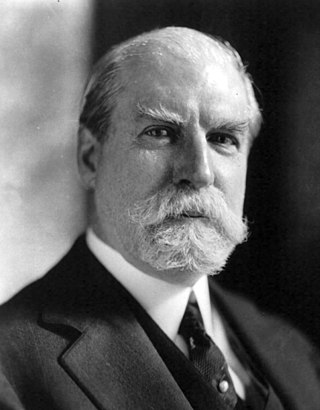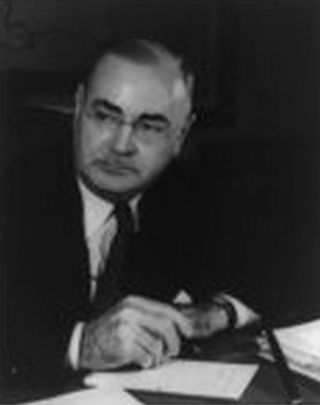
Charles Evans Hughes Sr. was an American statesman, politician, Cornell Law School Professor, and jurist who served as the 11th Chief Justice of the United States from 1930 to 1941. A member of the Republican Party, he previously was the 36th Governor of New York (1907–1910), an associate justice of the Supreme Court (1910–1916), and 44th U.S. Secretary of State (1921–1925), as well as the Republican nominee for President of the United States who lost a very close 1916 presidential election to Woodrow Wilson. Had Hughes won, he would have become the only former Supreme Court justice to be elected president.
Labour laws are those that mediate the relationship between workers, employing entities, trade unions, and the government. Collective labour law relates to the tripartite relationship between employee, employer, and union.
The Federal Trade Commission Act of 1914 is a United States federal law which established the Federal Trade Commission. The Act was signed into law by US President Woodrow Wilson in 1914 and outlaws unfair methods of competition and unfair acts or practices that affect commerce.

The National Labor Relations Act of 1935, also known as the Wagner Act, is a foundational statute of United States labor law that guarantees the right of private sector employees to organize into trade unions, engage in collective bargaining, and take collective action such as strikes. Central to the act was a ban on company unions. The act was written by Senator Robert F. Wagner, passed by the 74th United States Congress, and signed into law by President Franklin D. Roosevelt.

John Llewellyn Lewis was an American leader of organized labor who served as president of the United Mine Workers of America (UMW) from 1920 to 1960. A major player in the history of coal mining, he was the driving force behind the founding of the Congress of Industrial Organizations (CIO), which established the United Steel Workers of America and helped organize millions of other industrial workers in the 1930s, during the Great Depression. After resigning as head of the CIO in 1941, Lewis took the United Mine Workers out of the CIO in 1942 and in 1944 took the union into the American Federation of Labor (AFL).
A.L.A. Schechter Poultry Corp. v. United States, 295 U.S. 495 (1935), was a decision by the Supreme Court of the United States that invalidated regulations of the poultry industry according to the nondelegation doctrine and as an invalid use of Congress' power under the Commerce Clause. This was a unanimous decision that rendered parts of the National Industrial Recovery Act of 1933 (NIRA), a main component of President Franklin D. Roosevelt's New Deal, unconstitutional. The case from which the ruling stemmed was nicknamed the "Sick Chicken Case".
The Fair Deal was a set of proposals put forward by U.S. President Harry S. Truman to Congress in 1945 and in his January 1949 State of the Union address. More generally, the term characterizes the entire domestic agenda of the Truman administration, from 1945 to 1953. It offered new proposals to continue New Deal liberalism, but with a conservative coalition controlling Congress, only a few of its major initiatives became law and then only if they had considerable GOP support. As Richard Neustadt concludes, the most important proposals were aid to education, national health insurance, the Fair Employment Practices Commission, and repeal of the Taft–Hartley Act. They were all debated at length, then voted down. Nevertheless, enough smaller and less controversial items passed that liberals could claim some success.

The National Recovery Administration (NRA) was a prime agency established by U.S. president Franklin D. Roosevelt (FDR) in 1933. The goal of the administration was to eliminate "cut throat competition" by bringing industry, labor, and government together to create codes of "fair practices" and set prices. The NRA was created by the National Industrial Recovery Act (NIRA) and allowed industries to get together and write "codes of fair competition". The codes intended both to help workers set minimum wages and maximum weekly hours, as well as minimum prices at which products could be sold. The NRA also had a two-year renewal charter and was set to expire in June 1935 if not renewed.

The "Four Horsemen" was the nickname given by the press to four conservative members of the United States Supreme Court during the 1932–1937 terms, who opposed the New Deal agenda of President Franklin D. Roosevelt. They were Justices Pierce Butler, James Clark McReynolds, George Sutherland, and Willis Van Devanter. They were opposed by the liberal "Three Musketeers"—Justices Louis Brandeis, Benjamin Cardozo, and Harlan Stone. Chief Justice Charles Evans Hughes and Justice Owen J. Roberts controlled the balance. Hughes was more inclined to join the liberals, but Roberts was often swayed to the side of the conservatives.

Philip Murray was a Scottish-born steelworker and an American labor leader. He was the first president of the Steel Workers Organizing Committee (SWOC), the first president of the United Steelworkers of America (USWA), and the longest-serving president of the Congress of Industrial Organizations (CIO).
The Square Deal was Theodore Roosevelt's domestic program, which reflected his three major goals: conservation of natural resources, control of corporations, and consumer protection.
The Lochner era is a period in American legal history from 1897 to 1937 in which the Supreme Court of the United States is said to have made it a common practice "to strike down economic regulations adopted by a State based on the Court's own notions of the most appropriate means for the State to implement its considered policies". The court did this by using its interpretation of substantive due process to strike down laws held to be infringing on economic liberty or private contract rights. The era takes its name from a 1905 case, Lochner v. New York. The beginning of the era is usually marked earlier, with the Court's decision in Allgeyer v. Louisiana (1897), and its end marked forty years later in the case of West Coast Hotel Co. v. Parrish (1937), which overturned an earlier Lochner-era decision.
The Conservative Manifesto was a position statement drafted in 1937 by a bipartisan coalition of conservative politicians in the United States. Those involved in its creation included longtime opponents of President Franklin Roosevelt's New Deal as well as former supporters who had come to believe its programs were proving ineffective.
Carter v. Carter Coal Company, 298 U.S. 238 (1936), is a United States Supreme Court decision interpreting the Commerce Clause of the United States Constitution, which permits the United States Congress to "regulate Commerce... among the several States." Specifically, it analyzes the extent of Congress' power, according to the Commerce Clause, looking at whether or not they have the right to regulate manufacturing.
The New York State Department of Labor is the department of the New York state government that enforces labor law and administers unemployment benefits.

The New Deal was a series of programs, public work projects, financial reforms, and regulations enacted by President Franklin D. Roosevelt in the United States between 1933 and 1939. Major federal programs and agencies included the Civilian Conservation Corps (CCC), the Works Progress Administration (WPA), the Civil Works Administration (CWA), the Farm Security Administration (FSA), the National Industrial Recovery Act of 1933 (NIRA) and the Social Security Administration (SSA). They provided support for farmers, the unemployed, youth, and the elderly. The New Deal included new constraints and safeguards on the banking industry and efforts to re-inflate the economy after prices had fallen sharply. New Deal programs included both laws passed by Congress as well as presidential executive orders during the first term of the presidency of Franklin D. Roosevelt.
The 1927 Indiana bituminous strike was a strike by members of the United Mine Workers of America (UMWA) against local bituminous coal companies. Although the struggle raged throughout most of the nation's coal fields, its most serious impact was in western Pennsylvania, including Indiana County. The strike began on April 1, 1927, when almost 200,000 coal miners struck the coal mining companies operating in the Central Competitive Field, after the two sides could not reach an agreement on pay rates. The UMWA was attempting to retain pay raises gained in the contracts it had negotiated in 1922 and 1924, while management, stating that it was under economic pressure from competition with the West Virginia coal mines, was seeking wage reductions. The strike proved to be a disaster for the union, as by 1929, there were only 84,000 paying members of the union, down from 400,000 which belonged to the union in 1920.

John Michael Carmody was an American administrator, noted as editor of Factory and Industrial Management, and as administrator of the Rural Electrification Administration and the Federal Works Agency in the 1930s.
The New Deal often encountered heavy criticism, and had many constitutional challenges.
Bituminous Coal Operators Association (BCOA) is a coal mining lobbying organization. It was founded in 1950 by various companies to deal with the UMWA and unionizing of mines during the change from human labor to mechanical labor. The BCOA would strike deals between miners, mine companies, and coal buying companies to provide a steady flow of continuous labor and a steady purchasing price for coal. The main deals normally contained negotiations of some miners being put out of work by mechanizations while the miners left would be guaranteed a steady job and pay as long as they agreed to not hold up progress with strikes and other activities. In addition, the BCOA hears requests from the UMWA employees for pay raises but often results in unprotected employees being laid off after a deal has been reached. The current president of BCOA is David M Young. He is the main representative for the BCOA and lobbyist.







